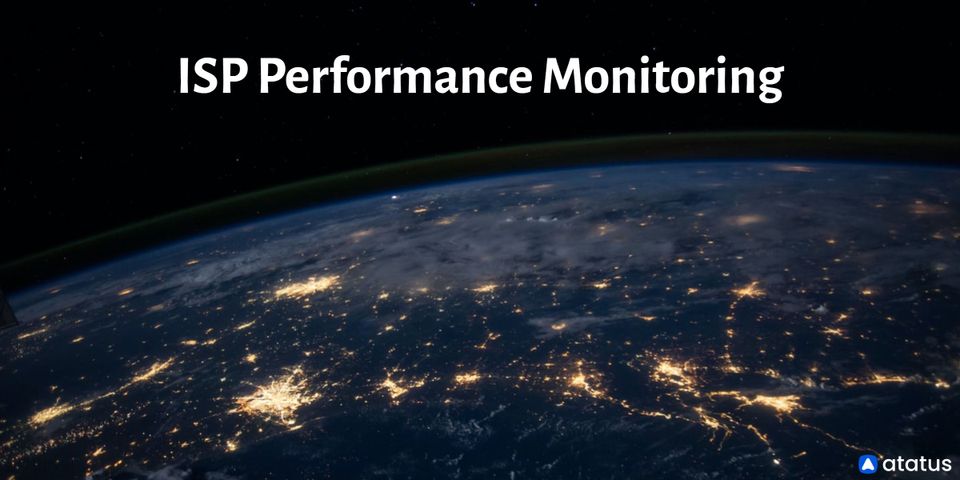Internet access and transit is a vital dependence whether you're a digital business with revenue-generating mobile applications, or an enterprise implementing modern SD-WANs and branch dedicated Internet access (DIA) to applications operating in IaaS or SaaS clouds. You can't assure the connectivity you need to run your business unless you have access to essential ISPs' peering and transit data.
We will cover the following:
- What is ISP?
- What is ISP Performance Monitoring?
- How to Monitor Your ISP Connection?
- Why Should You Monitor ISP Connectivity?
- Importance of Monitoring Customer ISPs
- Why ISP Performance Monitoring is Important?
What is ISP?
An ISP is a corporation that provides Internet connectivity to individuals and other businesses, as well as other associated services like Web site development and virtual hosting. An Internet service provider (ISP) has the necessary equipment and telecommunications line access to set up an Internet point-of-presence for the geographic area it serves.
Larger Internet service providers have their own high-speed leased lines, minimizing their reliance on telecommunications carriers and allowing them to deliver better service to their consumers. AT&T WorldNet, IBM Global Network, MCI, Netcom, UUNet, and PSINet are among the major national and regional ISPs.
MAE (MCI WorldCom's ISP switching centres) or similar centres are used to connect the largest ISPs. Peering agreements are the agreements they establish to exchange traffic. On the Internet, there are several fairly extensive lists of ISPs from around the world.
An ISP is sometimes known as an Internet Access Provider (IAP). To distinguish a service provider that is an independent, separate company from a telephone company, ISP is frequently used as an abbreviation for an independent service provider.
What is ISP Performance Monitoring?
The process of visualizing and monitoring internet services and how they connect your websites with your users and cloud resources is known as ISP Performance Monitoring. ISP Performance Monitoring allows you to monitor ISP connections, find individual ISP traffic connections with high latency, and detect interfaces with loss across the whole service delivery chain using a combination of active and passive techniques.
How to Monitor Your ISP Connection?
Monitoring your ISP connection is similar to other areas of application performance monitoring in that it entails gathering relevant data, responding to critical issues, and efficiently visualizing and analysing the metrics that matter the most.
To avoid an avalanche of data that becomes too difficult to manage, a good monitoring solution will smoothly incorporate the following:
- Advanced algorithms that look for patterns to determine which networks are the source of routing problems.
- Intelligent alerting ensures that only the issues that are relevant to your operation, such as packet loss or latency, are brought to your attention.
- Information can be quickly shared, monitored, or analysed with the appropriate teams or members via interactive dashboards or reports.
ISP monitoring used to be reactive rather than proactive. Support tickets, customer complaints, third-party suppliers like Down Detector, and ISP status pages were all used to detect problems. Performance concerns had most likely already harmed business outcomes at that point, and finding the actual root of the problem was a far more time-consuming task. Taking a proactive approach minimizes MTTR while also improving the customer experience.
Why Should You Monitor ISP Connectivity?
The internet is becoming the enterprise communications backbone is the main reason for monitoring.
- Detect ISP interruptions and their impact on enterprise services in advance
- Obtain visibility into your data center or WAN Internet transit connections
- View the evolution of forwarding paths over time
- Validate the SLAs that ISPs have agreed to
- Locate lossy interfaces and high-latency connections
- Share information with your ISPs about specific problem interfaces and links
Importance of Monitoring Customer ISPs
Web performance monitoring companies have a simple goal: to give their customers the most comprehensive and accurate picture of the health of their online systems as possible. This goal is achieved in a variety of ways, the most essential of which is synthetic testing from servers connected to the internet backbone.
By employing these nodes as "dummy computers" on which to run tests of their websites and applications, businesses can receive vital data about how their sites and applications are functioning, as well as how peering issues, connectivity bottlenecks, and other variables are affecting their overall performance.
There are two types of network providers:
- Transit Providers (Cogent, Level3, NTT)
- Last Mile Providers (Comcast, Verizon, AT&T, etc.)
Cogent does not sell the internet to end-users; instead, Comcast does. However, you purchase connectivity from backbone providers such as Cogent or Level3 or subscribe to peering exchanges in your datacentre.
To date, a monitoring tool's most accurate perspective of the end-user experience includes nodes on these two types of networks, with a focus on "Eyeball" or Last Mile networks like Comcast, AT&T, and others - i.e. Internet service providers (ISPs) that end-users utilize to access the internet.
This principle has become even clearer in recent years as a result of the fight over net neutrality, during which it was revealed that some of these ISPs use throttling techniques on their networks to favour certain websites while slowing service for others.
How were companies supposed to know if bad performance was due to difficulties on their end or with the consumer ISPs themselves?
Well, you have an answer for that… ISP Performance Monitoring!!!
Why ISP Performance Monitoring is Important?
Now that the internet has become a core element of practically every area of running a business, ISP performance monitoring is critical. Comprehensive monitoring provides a road map that displays the health of your network and application performance, as well as useful insight into user behaviour and experiences, which is crucial to business outcomes. ISP Monitoring also allows for the validation of service level agreements (SLAs) to guarantee that providers are adhering to their contractual responsibilities.
The visibility of legacy ISP monitoring solutions was limited to internal networks, making it difficult to locate and fix performance issues or outages. As the digital world shifted to include cloud-based services, the ability to monitor activity outside of your own system became increasingly important for understanding and enhancing network and application performance.
Comprehensive ISP monitoring combines passive and active monitoring approaches to allow you to continuously monitor ISP connections across your whole service delivery chain, allowing you to discover and fix traffic lines that are experiencing loss or slowness.
Conclusion
Performance is a process, not a destination; it's a never-ending process that can always be bettered. As a result, we'll continue to invest in testing capabilities and ISP Performance Monitoring to provide customers with the most complete picture possible.
Monitor Your Entire Application with Atatus
Atatus provides a set of performance measurement tools to monitor and improve the performance of your frontend, backends, logs and infrastructure applications in real-time. Our platform can capture millions of performance data points from your applications, allowing you to quickly resolve issues and ensure digital customer experiences.

Atatus can be beneficial to your business, which provides a comprehensive view of your application, including how it works, where performance bottlenecks exist, which users are most impacted, and which errors break your code for your frontend, backend, and infrastructure.





